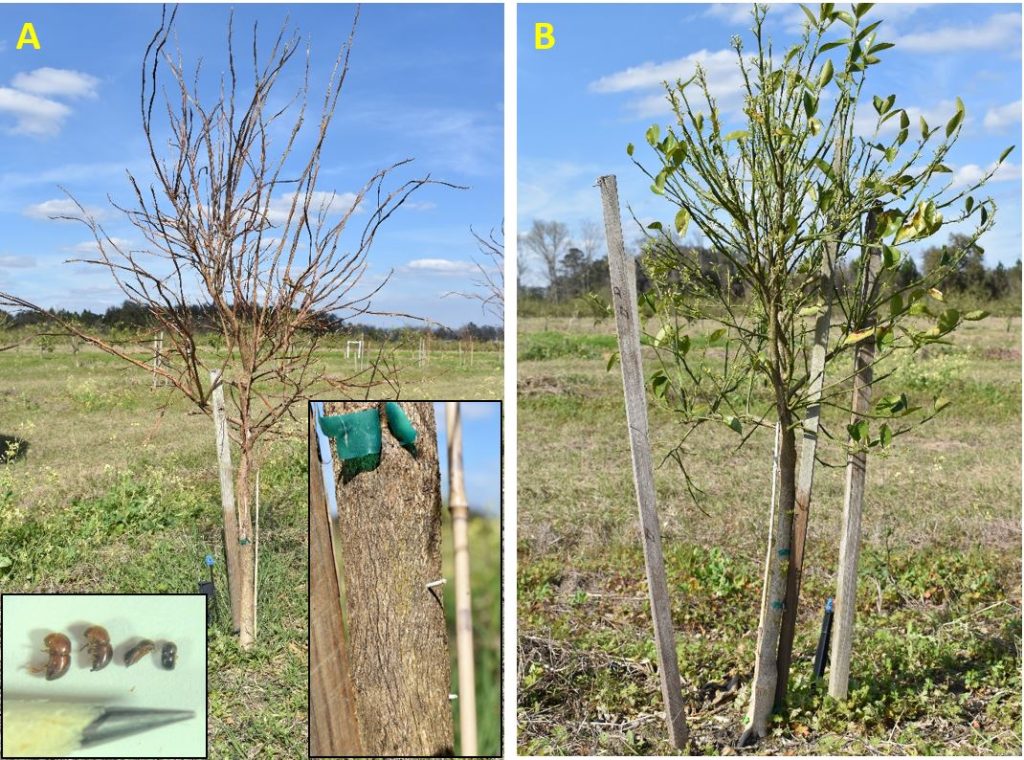Citrus growers in Georgia have been grappling with damage to their trees from the freeze event that came through before Christmas last year. We are still evaluating the impact of that freeze event on citrus varieties grown in Georgia and north Florida. The good news is that the majority of the citrus grown in Georgia are cold-hardy satsumas and most of them appeared to have survived the freeze. However, other citrus varieties such as grapefruits, tangos, navels, lemons, and shiranuis had more damage. The freeze event was like a natural field experiment to select citrus varieties suitable to grow in our region. I think we are going to learn a lot from this experience about the varieties, rootstocks and other crop management aspects. The recent Georgia Citrus Association Meeting in Tifton offered some valuable knowledge and insights on how to manage the surviving trees going forward.

While I hate to add another element to think about in your citrus operation, ambrosia beetles could be a potential concern at this time. I have been working on ambrosia beetles, a small insects that bore holes into stressed trees. On pecan we see these insects attacking young trees, which are experiencing stress conditions such as saturated roots, drought, or mechanical injury. This is the first time I have witnessed an infestation of ambrosia beetles in citrus trees. Jake and I recently visited a young orchard in Lowndes County, and a number of plants had a high level of ambrosia beetle infestation. However, the plants which had the ambrosia beetle infestation, as indicated by the sawdust toothpicks, were already damaged significantly following the freeze event (picture on the left, Fig. 1A). We did not notice little to no ambrosia beetle infestation on trees which looked healthy and had lots of green leaves. It was comforting to see that the young, healthy trees were probably not vulnerable to the ambrosia beetles. But we want to make sure that the surviving trees are not stressed further and to protect the trees from potential pests and diseases. Therefore, I would urge growers and crop consultants to closely inspect citrus trees, especially those which have green leaves or emerging leaves for any symptoms of ambrosia beetle attack.
With the onset of spring and temperatures in the 80s, ambrosia beetles leave the woods and seek new host trees. Most of the attacks should be limited to the lower part of the tree about 2 to 3 feet above the soil. Unfortunately, there is not a good curative measure to control the ambrosia beetles as they actually do not feed on the tree. They make holes to build their home and produce the next generation. A number of research scientists from the southeastern states are working on understanding more about ambrosia beetles and their management as these beetles affect many tree crops including pecans, peaches, apples and even nursery trees. At this moment, the best approach to prevent or reduce the chance of ambrosia beetle attack on young trees is to apply pyrethroid insecticide on the lower half of the tree trunk. Pyrethroids can both kill and repel ambrosia beetles that come in contact with the treated tree surface. Pecan growers are dealing with this pest for the past several years and I have seen growers having success by painting the lower part of the tree (again 2-3 feet from the ground depending on tree size) with white latex paint and spray pyrethroid on top. This method is likely to increase the retention of the active ingredient for a longer time. I hope we do not experience this type of freeze event again so trees can recover and be productive. I understand that this is a trying time for the citrus growers of the state as they are dealing with a lot of decisions. Be sure to watch your citrus trees closely for any damage whether it is from the freeze event or ambrosia beetles.
If you have any questions or would like to share any information, please contact one of us.
Apurba Barman (abarman@uga.edu; 209-285-9810)
Jake Price (jprice@uga.edu; 229-333-5185)